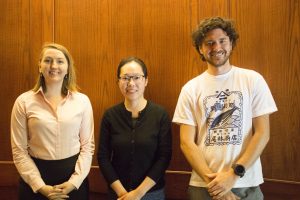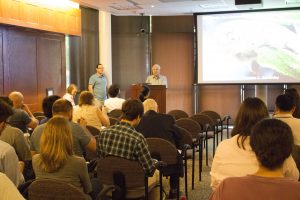

UNC Lineberger presented three postdoctoral fellows with The Joseph S. Pagano Award on Wednesday, June 6, in recognition of their published research.
Thomas Boothby, PhD, Hui Feng, PhD, and Jenna Honeycutt, PhD, were honored in a luncheon ceremony in the Pagano Conference Room at UNC Lineberger. The ceremony began at noon, and each award winner gave a 15-minute presentation.
The award is named for Joseph Pagano, MD, UNC Lineberger director emeritus and Lineberger Professor of Cancer Research, and funded by a gift from the Burroughs Wellcome Fund. It was established in 2002 to recognize noteworthy papers authored by the UNC Lineberger’s postdoctoral fellows. Pagano was the founding director of the cancer center, and of the center’s postdoctoral training program.
Boothby is a Simon Foundation Fellow of the Life Sciences Research Foundation in the UNC-Chapel Hill Department of Chemistry. He was honored for his work on the paper, “Tardigrades use intrinsically disordered proteins to survive desiccation,” which was published in Molecular Cell. The study identified a protein that allows tardigrades – microscopic animals sometimes known as “water bears”– to survive in extremely dry conditions. Researchers hope that the findings can be a useful step toward developing new methods to preserve vaccines.
“Given the importance of both prophylactic and therapeutic vaccines in cancer, and the high cost of vaccine storage cold chains, his findings have strong potential to be transformative for developing an important application from basic research,” said one of Boothby’s mentors, Bob Goldstein, PhD, a UNC Lineberger member and James L. Peacock III Distinguished Professor of Biology at UNC-Chapel Hill. Goldstein was senior author of the paper.
Feng is a postdoctoral research associate at UNC Lineberger working in the laboratory of Stanley Lemon, MD, UNC Lineberger member and a professor of medicine, microbiology and immunology in the UNC School of Medicine. She was nominated for her work on a study that described how the innate immune signaling molecule NRLX1 controls hepatitis virus infections. The paper, “NLRX1 promotes immediate IRF1-directed antiviral responses by limiting dsRNA-activated translational inhibition mediated by PKR,” was published in Nature Immunology.
“Hui’s groundbreaking work on NLRX1 signaling demonstrates how this innate immune mediator contributes to host control of infections with hepatitis C, the leading cause of hepatocellular carcinoma in the United States and many other countries outside of Asia,” Lemon said.
Honeycutt was honored for her work suggesting that macrophages are a reservoir for HIV. Current strategies to cure people of HIV focus on purging virus living inside T cells, which are the main target of HIV infection. But researchers wanted to know if macrophages are also playing a role in allowing the virus to persist by harboring virus that can re-initiate infection after treatment. The study, “HIV persistence in tissue macrophages of humanized myeloid-only mice during antiretroviral therapy” was published in Nature Medicine.
“Previously, dogma indicated that resting T cells were the only persistent reservoir for HIV,” said UNC Lineberger’s J. Victor Garcia, PhD, a professor in the UNC School of Medicine Division of Infectious Diseases, and the study’s senior author. “Her results demonstrate that HIV-infected macrophages can persist infected without any evidence of virus replication in vivo after antiretroviral therapy interruption. These important results are paradigm-changing to the entire field of HIV cure research since they demonstrate a new type of cell where HIV can persist in vivo and reinitiate infection.”
